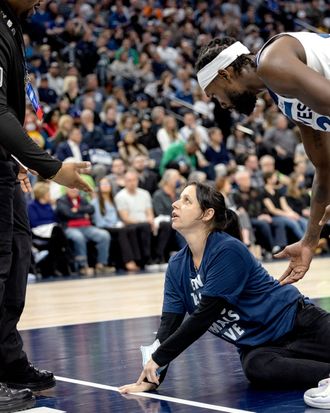
During the third quarter of Saturday’s NBA playoff game between the Minnesota Timberwolves and the Memphis Grizzlies, a spectator named Sasha Zemmel jumped out of her seat, rushed onto the court, and was promptly slammed to the floor by a security guard. It was not immediately clear what she had planned to do, but where she ended up — pinned to the hardwood by more guards, then carried out by her limbs and taken into police custody — was not inspiring. Many observers laughed at her. By the time the animal-rights group Direct Action Everywhere claimed responsibility for her actions, Zemmel’s mishap had been memed, with several of the glib responses praising the guard who took her down. The actual goal of the protest — which, according to DAE’s statement, involved Zemmel dressing like a referee and calling a “technical foul” on Timberwolves owner Glen Taylor because he owns a cruel chicken farm — was mostly lost.
The last decade has given Americans a skewed impression of protests. Between Black Lives Matter, the Women’s March, and the January 6 storming of the U.S. Capitol, the latest wave has been characterized as a battle for the nation’s soul. Its flare-ups were the height of patriotism, signs of a leftist revolutionary moment, a decisive step toward fascist authoritarianism, or something equally grandiose depending on whom you asked. Part of what encouraged these interpretations was size — the George Floyd protests of 2020 were the largest in U.S. history — and how quickly people developed favorable opinions about them. When the Pew Research Center polled Americans about their views on the resurgent Black Lives Matter movement less than three weeks after Floyd’s death, large majorities were supportive. The Capitol riots expressed a conspiracy theory that has since become an organizing principle of the Republican Party.
It was easy to forget, for a moment, that most protests do not inspire polarizing views one way or another. The bulk are regarded, if they are regarded at all, with a mix of skepticism, annoyance, and indifference. The last wave gave us iconic images — Edward Crawford throwing a tear-gas canister and Jacob Chansley prowling the halls of Congress, each wearing American-flag patterns — reminiscent of the clashes and factions that defined the civil-rights movement of the 1950s and ’60s. But the archetypal vision of U.S. protest is still the lone crank on the street corner waving a handmade sign; to describe him as generally disliked is both empirically true and too generous. Most protesters are lucky to get noticed — in Zemmel’s case, merely to have people see her get tackled onto a basketball court — and have people feel anything at all.
Even then, drawing attention to yourself is a mixed blessing. Often when protesters start being taken seriously, public antipathy against them ratchets up. Sympathy varies by cause, but according to the Roper Center for Public Opinion Research at Cornell University, each of the major American protest movements of the past 75 years — from the civil-rights and the anti–Vietnam War movements to the student-led push for divestment from apartheid South Africa and the anti-abortion protests of the 1980s — was viewed with disfavor in its day. Neither Occupy Wall Street in 2011 nor pre-2020 Black Lives Matter had majority support. And God forbid they morph from conceptual irritants to physical impediments: Over the past few years, protesters who blocked traffic have been greeted with proposed laws to protect motorists who try to kill them.
The peculiar case of Black Lives Matter — a crude catchall term for the assortment of anti-racism activity that caught the public’s attention after Trayvon Martin was killed in 2012 — showcases another drawback: the scapegoating that comes with going mainstream. Almost from the moment it started to be seen as good for lawmakers and businesses to align themselves with the movement, protesters started to get blamed for their long-standing failures. Police were demoralized and neglected their sworn duties because protesters criticized them. Democrats lost elections because their candidates got linked to protester demands that were seen as too radical. Negotiators on federal reform law abandoned even moderate ideas because it was easier, and more politically fruitful, to attribute them to protesters and the pols who seemed sympathetic to them.
The reinvestment in policing that greeted BLM feels preordained in this light. Dissent across a range of areas — from the Standing Rock water protectors to the March for Our Lives against gun violence — might have been glowingly assessed by progressive media outlets and politicos, but the trait that continues to define them is how profoundly their demands have been neglected. This suggests that even our weird age of popular protest follows a familiar script. Causes that have broad approval still languish in obscurity. Wynn Alan Bruce set himself on fire in front of the U.S. Supreme Court on Friday to protest inaction to curb global warming. It barely registered as national news.
When Zemmel got tackled over the weekend, she was in this unglamorous position of sacrificing her body, and maybe some of her dignity, for a cause that lots of people seem to support but that remains stubbornly status quo. According to a 2020 public-opinion survey commissioned by the ASPCA, large majorities of Americans really are worried about the safety risks posed by industrial animal agriculture. Timberwolves owner Taylor, the richest man in Minnesota, owns a factory farm business in Iowa, Rembrandt Enterprises, which was exposed by Direct Action Everywhere to have engaged in animal cruelty. During a recent outbreak of avian flu, the company shuttered the vents to the sheds where it keeps its chickens and flooded them with high heat, killing more than 5 million birds.
It was exactly the type of incident that, according to the ASPCA, leads almost three-quarters of people who hear about it to seek “alternatives to factory-farmed meat” when buying food. Zemmel and her group are calling on Taylor to donate federal subsidies he received as a result of the flu outbreaks to “public-health charities and animal sanctuaries” and step down early from the Timberwolves’ day-to-day operations (he’s selling the team, effective next year) — both of which will almost certainly not happen.
But all protests start out as marginal. It doesn’t automatically make them righteous or worthwhile, but failing to express the views of the majority, a favored accusation among their detractors, is universal enough that it works poorly as a critique. Acceptance takes time. The areas where they can be effective in the short term — nudging public opinion, putting strategically timed pressure on political candidates — are borne out by research, as is how long it usually takes to appreciate them. The consistent trend across movements in the U.S., especially but not limited to civil rights and its once reviled avatar, Martin Luther King Jr., is that they’re almost always liked better in retrospect. Fewer than 20 percent of Americans had favorable views of the 1963 March on Washington at the time, Gallup found. Now its most famous sound bite — “I have a dream” — is trumpeted by the same reactionary politicians fighting to undo King’s legacy.
Zemmel’s was the third protest of its kind at a Timberwolves game. Earlier iterations saw a protester chain herself to the stanchion that holds up one of the hoops and another glue herself to the court. Each has been greeted with dismissal or derision by most commentators, few of whom gave activists the satisfaction of explaining their cause to viewers, which would have been a coup. They have instead been memorialized, so far, mainly as jokes — mildly inconvenient but amusing examples of how zany the NBA playoff atmosphere can get — and ultimately not worth dwelling on. There is no guarantee this won’t be their plight forever. But protests tend to be wrong until they’re right.






























